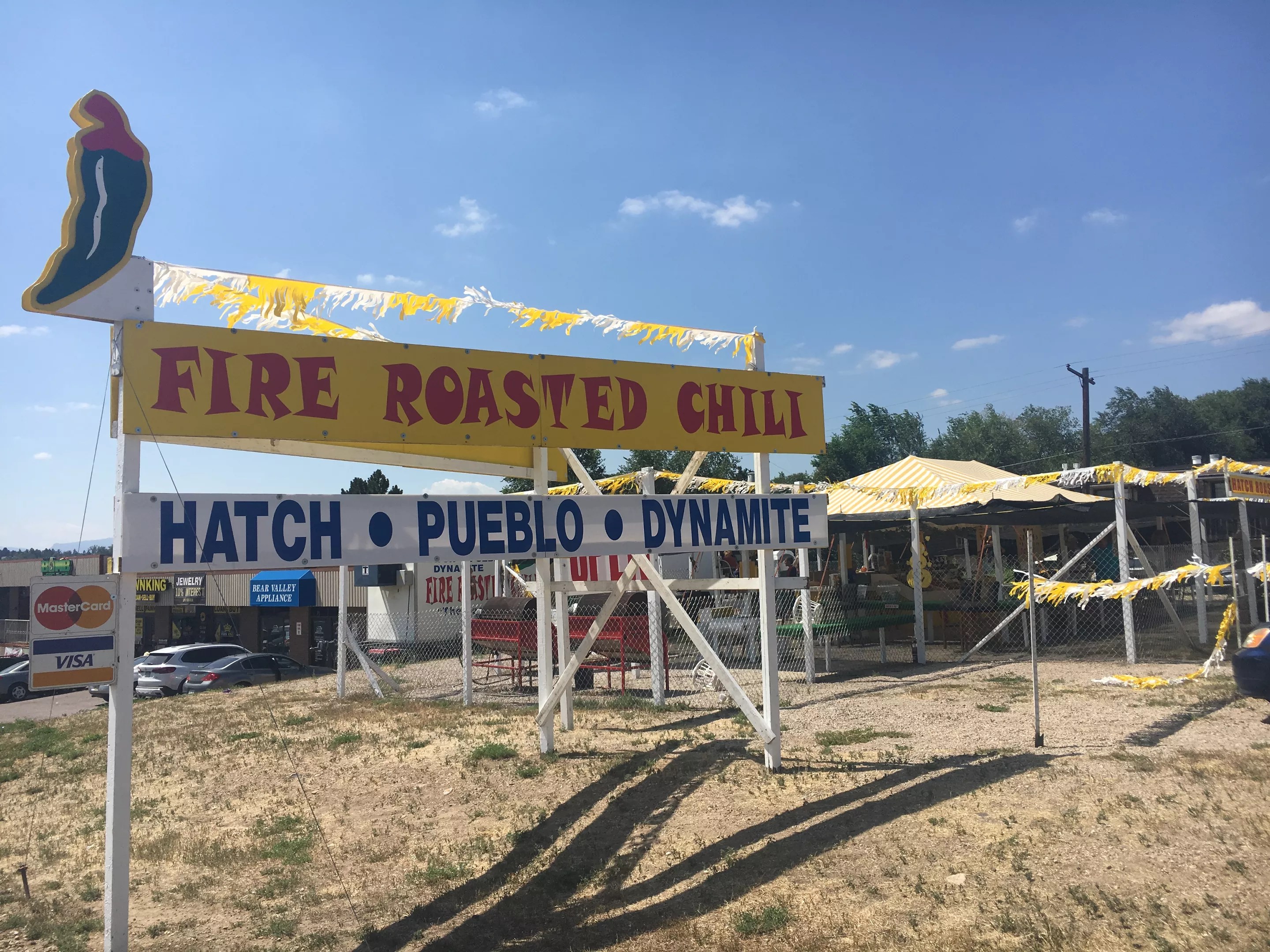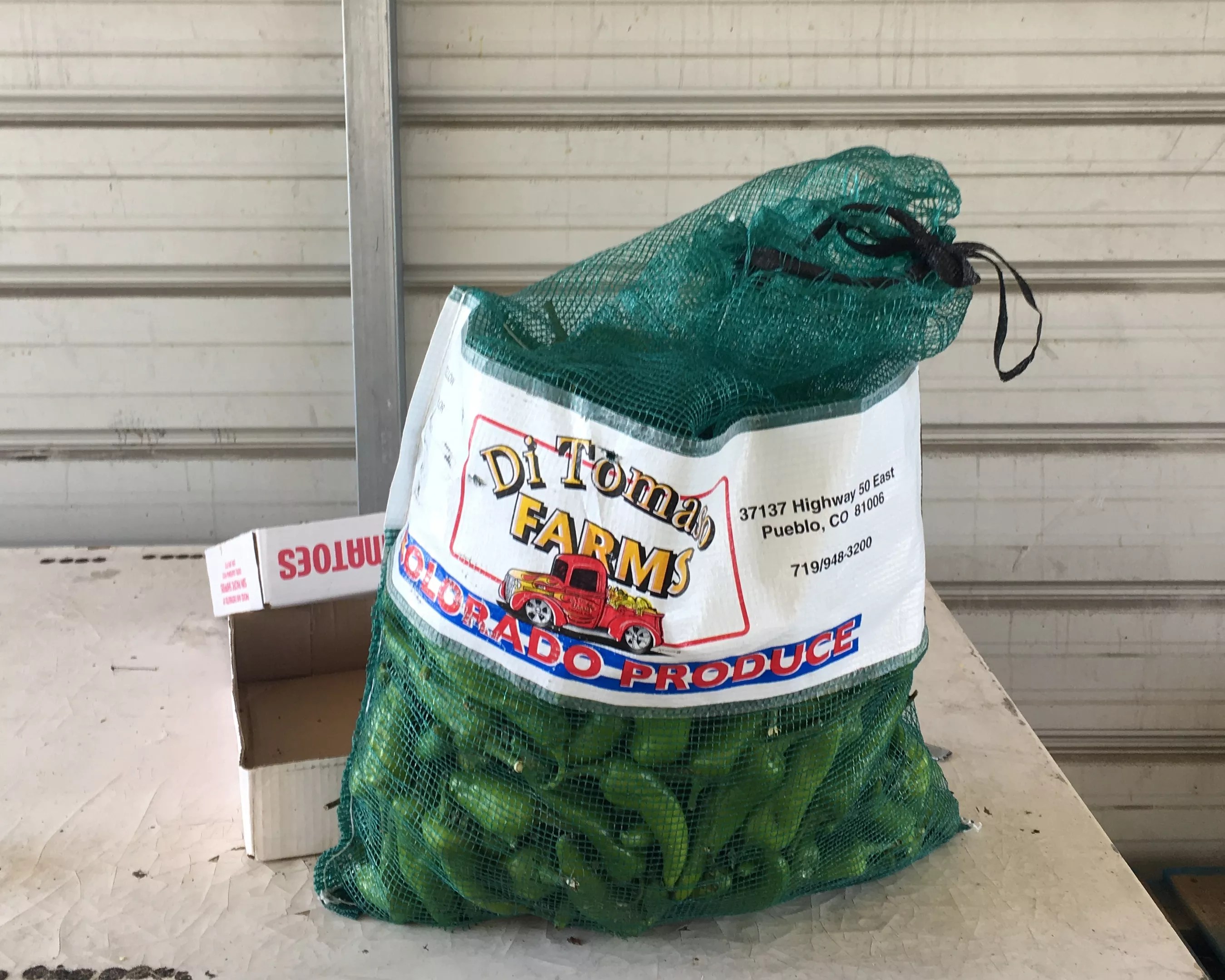
Mark Antonation

Audio By Carbonatix
A basket half full of glossy green pods sits on a folding table with a sign that reads “Pueblo Mosco.” It’s late August, and that lone basket holds the only Pueblo chiles for sale at a South Federal Boulevard roadside stand near Hampden Avenue. There are plenty of Hatch chiles available, though, and the roaster fills the air with smoke, flecks of burnt chile skins wafting like black snow, and an aroma that’s nostalgic and intoxicating to anyone who’s lived in New Mexico or Colorado.
A couple of cars pull into the gravel parking lot, adding a whorl of dust to what’s already in the air. One woman says she’s driven all the way across town for Pueblo chiles, and her face visibly sags as she receives the news that a fresh truckload won’t be arriving for another two hours. She leaves disappointed.
Another man switches his order to Hatch after he sees that his favorite Dynamites, an especially incendiary Pueblo variety, have not yet arrived. The vendor loads up the roaster and tumbles the chiles like bingo balls, keeping them moving in their wrought-iron cage so that each pod gets an even scorching from the roaring propane flame.

A green chile stand near South Federal Boulevard and West Hampden Avenue sells both Hatch and Pueblo varieties.
Mark Antonation
Cold, wet weather at the beginning of the growing season has delayed this year’s crop coming out of Pueblo, Colorado’s premier growing region for green chiles with names like Mosco, Dynamite and Mirasol. New Mexico’s Hatch Valley, on the other hand, has been sending up a steady stream of its famous chiles for several weeks now. But the vendor at this market promises that by the first week of September, his tables will be laden with bushels holding several Pueblo varieties with assorted heat levels.
A mile north on Federal, the story is even sadder. A vendor with a prominent “Pueblo Chiles” sign has only Hatch chiles for sale. She, too, says that the next week will be better. Two more stands along Federal advertise Hatch chiles only; one of them also has crates filled with melons, tomatoes and other late-summer produce.

DiTomaso is one of only a handful of Pueblo farms represented by the Pueblo Chile Growers Association.
Mark Antonation
Chile aficionados across the country swear by Hatch. Decades of New Mexico harvests have resulted in a reliable crop with predictable heat levels, and the sheer volume produced in Hatch creates a dependable supply from the end of July often well into October. Pueblo’s production, on the other hand, is just a fraction of New Mexico’s, and the weather makes the crop a little less certain. But Coloradans are a proud bunch, so they’ll seek out locally grown chiles. And those who have cooked with Pueblos rarely ever switch back, noting the homegrown chile’s firmer, thicker flesh and bolder flavor. (Most recommend using mild chiles for a big batch of green chile, though, to make it palatable for more people.)
Heinie’s Market pulls through for the home team. Heinz “Heinie” Silz opened his farmers’ market at 11801 West 44th Avenue in Wheat Ridge in 1950, selling seasonal produce straight from Colorado farms. Today Heinie’s is still run by the Silz family, and green chile season is a big deal at the spacious shop, which is currently brimming with popular melons, peaches, apples and sweet corn, as well as kohlrabi, cauliflower, broccoli and carrots from local and regional fields. “We’re famous for our green chile roasting,” says Laray Silz, granddaughter of the market’s founder.
Laray greets customers from behind a display table loaded with zip-top baggies plump with green chiles still warm from the roaster out front. Her hands are stained with black smudges from packing the roasted pods, which are labeled by origin and heat level. While Heinie’s can procure Hatch chiles from a local wholesaler whenever it runs low, she explains that Pueblo chiles come directly from the farms, so if the market runs out, it has to wait for a new truck to make the drive. Right now, though, the place has some in stock.

Heinie’s Market proudly displays its chile-roasting traditions in a street mural.
Mark Antonation
Heinie’s sells chiles from Millberger Farms and DiSanti Farms, among others. A mesh bag next to the roaster bears a DiTomaso label. Only a handful of farms are listed on the Pueblo Chile Growers Association website, including these three; the others are Peppers & Petals, Musso Farms, Mauro Farms, Pantaleo Farms and Vigil Farms, all of which operate their own green chile stands in or near Pueblo.
The DiSanti family has been farming in Pueblo since 1890. While this year’s wet weather put an early damper on the growing season, the hot, sunny July and August have helped farmers catch up. “There’s going to be a lot coming, but right now it’s kind of scarce,” explains RoseAnn DiSanti. “We plant in many different fields, so we don’t have all our eggs in one basket. Give us a week, two weeks, and we’ll have tons of chiles to send up.”
But in the meantime, I’m hungry to conduct my own taste test. So I pick up a couple of baggies from Heinie’s, one with Hatch and one with Pueblo chiles, about two pounds of each, labeled “hot” so I’ll have a direct comparison. Everyone I’ve talked to – roadside vendors, farmers and produce managers – agree that Pueblo chiles are generally hotter.
And they’re right: The heat of the Pueblos definitely lingers longer. But these chiles also carry a bright, grassy flavor that stands out from the slight smokiness of the roaster. While the Hatch chiles are trickier to cut and seed because the walls are thinner, they hold the smoky flavor better. After conducting a decidedly unscientific blind tasting (fresh Pueblo-made flour tortillas serve as a palate cleanser), the votes come in fairly even, with Pueblo getting a slight edge (and some sheepish tasters admitting they really can’t tell the difference).
If you’re pulling up to a parking lot tent, lured by the scent of roasting chiles, be alert to what you’re buying. I’ve heard about counterfeit Hatch chiles selling for a premium, but Laray Silz says the problem lies more in the size of the packaging. Most vendors unload their bushel bags into smaller baskets and then sell the reduced amount as a full or half bushel, she notes; look for vendors with branded mesh or burlap bags so you know that they’ve come directly from a farm or wholesaler, then eyeball those bags and compare them to what’s in the basket.
Heinie’s sells Hatch and Pueblo chiles for $3.49 per pound, roasted and bagged. Hatch chiles run $55 for a forty-pound bag before roasting. Unroasted hot Moscos sell for $38 a bushel, though it’s smaller than forty pounds. A bushel isn’t a common unit of measure for most of us; farmers describe it as the largest amount you’d be willing to carry by yourself for any distance. Although it’s a unit of volume, a bushel of green chiles usually weighs 20 to 22 pounds. Heinie’s will roast these for you, but you’re on your own for peeling, seeding and bagging – the most time-consuming part.
Back in July, Governor Jared Polis issued a green chile challenge to New Mexico Governor Michelle Lujan Grisham. The details of that contest have yet to be hammered out; I’d advise that the taste tests include raw and roasted chiles of an identical heat level as well as samples of green chile cooked using the same recipe but with chiles from the two warring regions. And I’d be happy to supply the recipe.
Over the weekend, I’ll be cooking up two separate batches of green chile using this simple recipe – just chiles (no tomatoes, corn, potatoes, thickeners or other non-essential interlopers), chicken stock, pork shoulder, garlic, onions, salt and a little lime juice – for a head-to-head contest between Hatch and Pueblo.
But I already know who the winner will be: This chile head, with a cold beer in one hand and two steaming pots of Southwestern goodness on the stove.